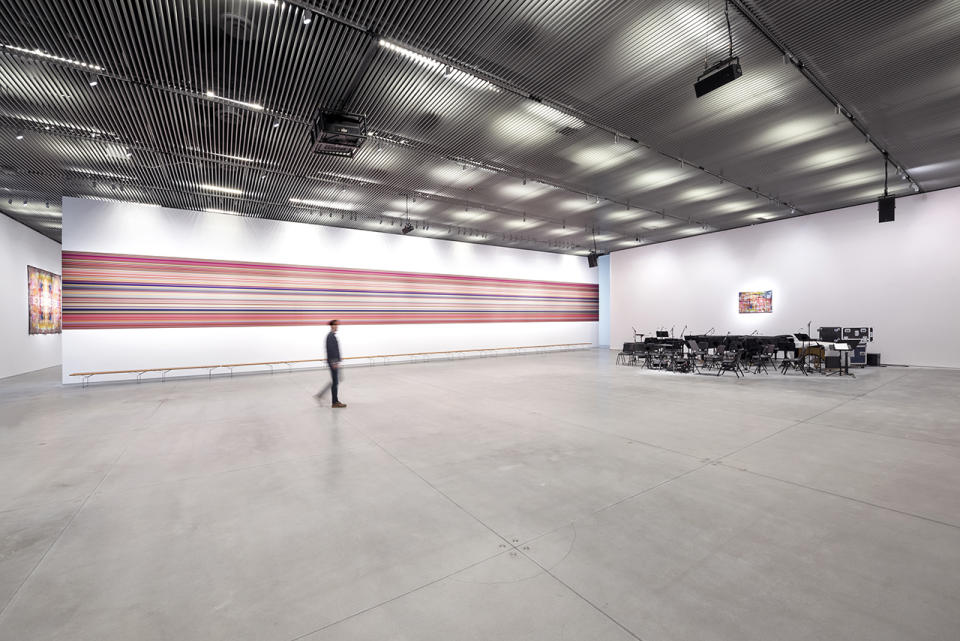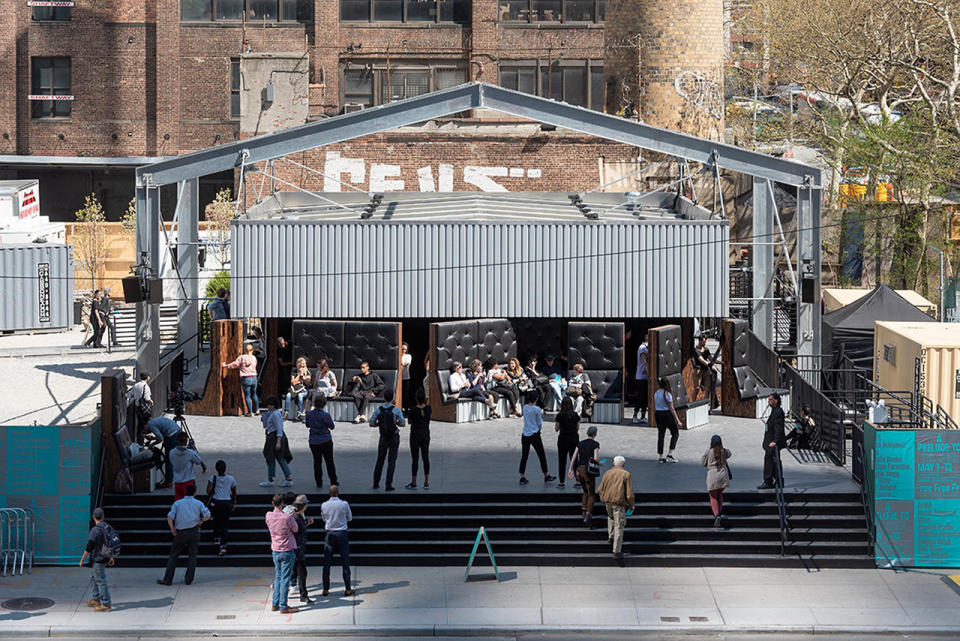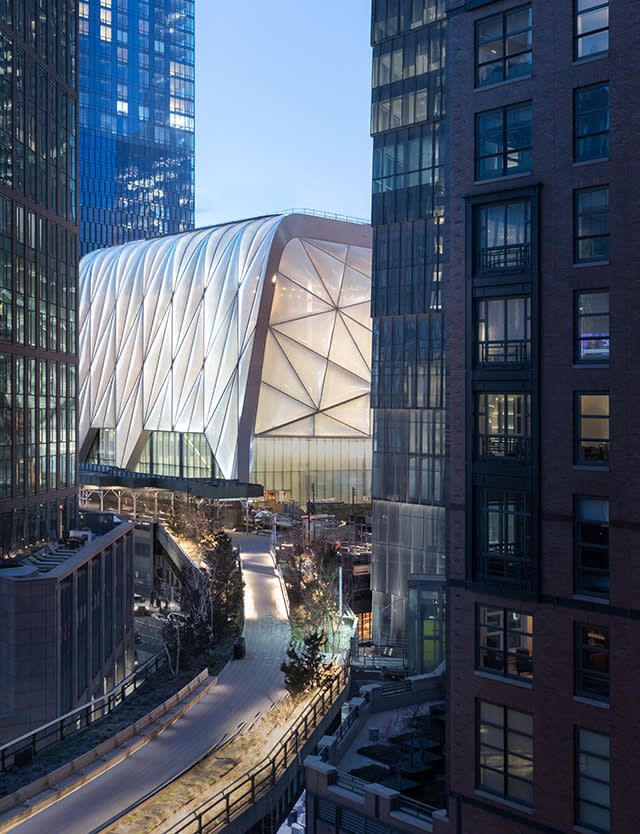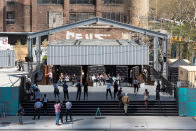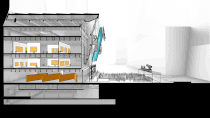The Shed and the art of the flex
A moving bid to become a NYC cultural institution.
The Shed's concept is simple: It's the 120-foot tall building that moves. This idea is both its architectural hallmark and its metaphor for the future of culture. Opening on Friday, New York City's half-billion dollar, hybrid museum-meets-performance space can shapeshift to double its indoor perimeter in five minutes. It's nestled by Hudson Yards, a shiny and pricey new smart neighborhood on Manhattan's once-blighted West Side, and this giant lurching structure is supposed to be malleable to any size or setup that a potential show might demand, whether it's Kendrick Lamar or New York Fashion Week. Next to four adjacent levels of gallery, theater and incubator space for artists is an extendable, puffy shell controlled by a crane-like system that drags six-foot wheels over steel rails. Push it out and you might have a heated concert hall; retract it fully and there's an outdoor plaza. "It's anything that we could think of that anybody might want a building to be," said Elizabeth Diller, founding partner at Diller Scofidio + Renfro, the much-lauded lead architects that worked on The Shed in collaboration with Rockwell Group. "I think of it as all muscle, no fat... there's nothing extraneous about it." The convertible system draws from the world of industrial machinery and shipping yards, which is where most moving architecture of this size exists. Kinetic elements have been applied to experimental buildings, sometimes responding to daylight or floating with rising tides. Modular interiors, meanwhile, have been used to save space in shoebox apartments. Yet a moving cultural institution of this scale is likely the first of its kind, according to Dan Howarth, former US editor of architecture and design magazine Dezeen. "It's so low tech that it is high tech," he said. The Shed was explicitly inspired by Cedric Price's Fun Palace, an unrealized design from 1960s London, which was also an influence on Paris' Centre Pompidou. But, said Howarth, "no one's ever used that idea and turned it into a proper building." The result has been called "gadget architecture." "a Toyota Prius engine moving a behemoth as finely-tuned as a Formula One car" and "an enormous tectonic foreskin," depending who you read. The sliding shell is a novel trick, an architectural flex in more ways than one. But you don't need kinetic construction to host different types of art. Venues like the Tate Modern in London, a former power plant on the riverside, perform similar functions in cavernous surroundings, even if they're not as space-efficient or purpose-built for the arts. Design, architecture and technology are not just functional, they shout a message. The Shed's arresting design is really an industrial-sized allegory for what it thinks the cultural temple of the future should be: infinitely flexible. A key conflict when you're designing a building that's supposed to be on the bleeding edge of technological sophistication and artistic evolution is that it might take 11 years to make. How do you future-proof 200,000 square feet of steel, glass and concrete? The answer, according to Diller, was to create a permanently responsive building -- an "architecture of infrastructure." "This idea really stems from those very original questions of what does flexibility mean and what are artists going to be doing in the next decade or two?" she said. "And the only reasonable answer was that nobody knew... you're building for an unknowable future." Yet Diller says she did not want to merely create a vacuous shell to be filled later. "Flexibility, most of the time, means generic: an open footprint, a big factory space, a big loft. And right from the beginning, I wanted to really challenge that by making an architecture that was highly specific, that was articulate, that was of its time, and that was something for artists to react to," she said. "It was the notion of flexibility with character." This is in some ways an ethos of architecture as technology -- a "product" or a "platform." It's a physical, presumably permanent manifestation of a culture of constant iteration. Like technology, cultural institutions are in profound flux. Spectators don't just sit in proscenium-style theaters, they wander and "immerse" in interactive art forms that don't fit neatly into visual, audio or performance. The hierarchies between "high art" of the old masters and "popular entertainment" of a multicultural internet generation are dissolving. And the diversity of audiences who can potentially access the works of The Museum of Modern Art (MoMA) simply through their smartphones is unprecedented. Museums -- classically mere vehicles of acquisition, preservation and display -- are in the throes of rethinking their fundamental purpose in a digital age. Any new institution has an opportunity to bake a new way of thinking about arts and technology into their organization from the start. "They can't pretend that the old means and methods that you would apply when opening a museum in the 1900s or the 1800s make sense when you're opening a destination cultural institution now," said Keir Winesmith, the former director of digital experience at SFMOMA and a consultant to cultural institutions on technology. "In my opinion, those organizations have the most to offer if they take [technology] seriously but also, in a funny way, have the most to lose. They can appear and disappear -- they don't have the cultural relevance of 100 years." While The Shed doesn't have a century of brand recognition, it has about half a billion other chips stacked in its favor. The organization has raised and spent money heavily. It's pulled in $529 million to date, with Michael Bloomberg donating $75 million on top of the $75 million in city money he provided when he was mayor. The Shed expects to spend about $50 million in its first year, according to the New York Times. Alex Poots, The Shed's top-rated artistic director and CEO, made just over $870,000 in 2017, according to the latest public tax returns filed by the nonprofit, in a town where compensation for heads of major arts centers can safely clear $1 million per year. (A spokesperson from The Shed declined to share Poots' current salary.) Yet his appointment was a coup for drawing star talent -- everyone from Björk to composer Arvo Pärt -- for the opening season. The Shed also has the tech knowhow. Daniel L. Doctoroff, the CEO of Alphabet's smart city moonshot Sidewalk Labs, who has also been deputy mayor of New York and CEO of Bloomberg, is The Shed's chairman of the board. "These notions of connectivity, the notion of this place being a platform for the creation and enjoyment of art is a very different thing [from other arts institutions], and I think everyone would sing from that same hymnal," he told Engadget. Ezra Wiesner, The Shed's chief technology officer, said: "We have people who are sympathetic to technology on the board, and understand that this is a major part of how The Shed's going to succeed, whereas in other legacy institutions you're making arguments about catching up all the time." An arts center today could be many things. A rarefied pedestal that bestows legitimacy on whichever artists the public should supposedly be paying attention to. A secular sanctuary for introversion and inspiration. A quasi-educational facility that interprets culture, telling us what it means and why it matters. A real-life community spot -- or "third place" -- in a mediated world, smashing people from varied economic and cultural backgrounds into each other in an environment where they're open to new experiences. At worst, it could be none of them: an elitist tourist magnet or a storehouse for works that are perceived as inaccessible, irrelevant or just dull. At a moment when only 16 percent of the US population claims to have visited a cultural organization in the last two years, The Shed could be unburdened by the inertia of legacy prestige but in the same big leagues when it comes to financial and staffing firepower. It is, in sum, an opportunity to articulate what the 21st-century cultural institution can be, at a time when its entire premise is up for grabs. If ever a building for the arts had the potential to be better -- more inclusive, more tech-forward, more plain interesting -- it's here. What could that even look like? Think of the way we watch sports, says Jake Barton, principal and founder of design firm Local Projects, which worked on the 9/11 Memorial Museum. Every moment of a World Series TV broadcast is seasoned with analysis. You'll know if a left-hander batter is facing a left-handed pitcher, how many times they've faced off and who usually comes out on top. Through commentators, graphics, stats and interviews, the experience is produced to tell you not just what's happening, but its significance. "They work hard to educate you around the drama that's embedded inside a very opaque art form," Barton said of sports producers. "They're just like, 'What does it take to get people into football? It takes drones? OK, we'll do drones. Does it take animations to show the structure of the plays? OK, we can do that. Does it take people with a dramatic voice that are building up the momentum? Sure.'" Barton -- whose wife is a classical oboeist -- contrasts that with a night at the New York Philharmonic. An expert can tell you why Igor Stravinsky's The Firebird is a masterpiece that brings audiences to tears. In another piece, they can point out why certain measures are so hard to play, or recount stories about that time an oboe player passed out in the middle of a solo due to the intricacies of the required breath control. "Now does that resemble anything of what anyone goes through when they go to the New York Phil? No... any of the context is stuck in the most pitiful sad fashion in 150 words at 9-point type, a third of the way through the Playbill, stuck between an ad for Chrysler and whatever," he said. "The maddening gulf for me between the incredible passion and artistry of these organizations and how that is framed and communicated to the audience is just sad. It's heartbreaking. And that to me is the challenge -- it's for The Met, it's for the Phil and it's also, frankly, for The Shed." Context, in other words, is king. It's as vital for a teenager encountering a Gerhard Richter painting for the first time as it is for an older opera fan watching the Brooklyn-born dance style flexing (both are in The Shed's lineup). With tech at their disposal, there are myriad experiments that arts institutions have attempted to gently insert as vital frames of reference -- museums have played with augmented reality and curators who answer questions by text message in real time. But in 2019, people's experiences of museums are not limited to their time at a physical building. They find their culture on the internet -- which is also where cultural organizations can locate audiences who lack the time, money or proximity to attend their sites. The Royal Shakespeare Company is playing with Magic Leap to create "tabletop theater." SFMOMA spent a summer riffing off emojis that anyone could text them by replying with an artwork from their collection (it went viral: 3.7 million text requests arrived in a month and a half). "What if you just considered the museum a media entity that happened to have a venue?" said Winesmith, who oversaw "Send me SFMOMA." "That's a way to be democratic in your access." Despite the confidence in its tech expertise, it's still fuzzy how The Shed will serve the digitally fluent, context-hungry visitor of 2019 in a fresh way. The Shed will livestream its opening night -- part one of a concert series celebrating African American music called Soundtrack of America -- via YouTube through a partnership with Live X. Last year, it announced a $25 million partnership with Altice USA for a high-speed fiber network. Wiesner, The Shed's CTO, says this could be the start of more ambitious live-streaming, taking cues from Twitch, esports and speedrunning. "With platforms like Twitch we're seeing a totally different kind of video engagement... it's really the gamer who's an expert taking you through the experience in a really different way," Wiesner said. Hypothetically, an artist could do the same thing at The Shed, walking audiences through installations and answering their questions. "I think that kind of interaction would spur on people actually wanting to go visit The Shed and the installation itself," he said. At the Philadelphia Orchestra, Wiesner helped to launch LiveNote, an app that provided a slideshow of information contextualizing each moment of the concert, measure by measure. "I would love to bring some of this to The Shed," he said. "Second-screen experiences that punctuate, contextually, what's happening right when you're there." Wiesner spoke of location tracking through Bluetooth beacons and WiFi access points, as well as investigating blockchain as a way to transfer tickets. It's still exploratory, though, and the peddling of The Shed so far as a "platform" can read two ways: a blank slate of opportunity for an artist to ideate on, or a current lack of focus for how the organization's tech can truly set itself apart. "Really, we're in build mode right now," Wiesner said. "The way I think of this whole thing is [we'll] build, operate and integrate, and then we're going to start doing innovation at the end." So far, the innovation is really in the arts programs The Shed has commissioned across disciplines. "My argument is that because there is a place for centers of excellence and always will be, [it] doesn't mean there isn't a place for somewhere that can encourage something that starts in a more amorphic way," said Poots. Existing centers like MoMA are readjusting to accommodate hybrids of performance and media; the Ronald O. Perelman Center for The Performing Arts at the World Trade Center is being designed for the same purpose. Still, it's rare to see an opening season with this much breadth, talent and celebrity heat, drawing on artists like the director Steve McQueen, singer Sia, composer Steve Reich, writers of Kung Fu Panda and poet Anne Carson. The Shed has also commissioned 52 up-and-coming local artists to create new work. The opening event is a celebration of African-American music through emerging artists like Victory, Smino and Eryn Allen Kane. Each musician will play covers of songs forming the lineage of their style, capping the set with their own original piece. It's a concise concept -- unpretentious and powerfully contextual for the audience. It's also a strong statement for another priority that The Shed has been vocal about: reflecting the multiculturalism of New York. "The question becomes can you thoughtfully and intelligently program in a way that is just as progressive as the building is trying to say that it is? If they get the program wrong, it won't matter, the shiny building won't save them," said Winesmith. "They're trying to create new genres, they're pushing the boundaries, it's not a bunch of famous white men -- and that I can't applaud enough. I think it's a really strong pitch that's differentiated. The open question is, is there an audience for it?" Look around your standard arts institution in America and this is what you're likely to see: white, college-educated home-owners with a household income of $113,000 per year. That's the profile of an average active visitor to cultural organizations, according to research company IMPACTS. Meanwhile four out of ten people say that art and history museums aren't for "people like me." At The Shed, everyone from the board down has spoken about how finding diverse audiences who may not picture themselves in a high-end New York art center is part of the mission. To that end, The Shed offers 10 percent of its tickets to low-income communities and has taken its flex dance program to schools and public housing. "We see ourselves as an incredibly inclusive cultural institution," said Doctoroff, the board chair. "That's really a driving force of who we are. This should be a place that is open to everyone, and everyone should be able to find things that they find interesting and everyone should feel welcome." Yet The Shed also shares oxygen with the new luxury mall and glassy skyscraper-filled smart campus that Michael Kimmelman, the New York Times' architecture critic, termed "this vast neoliberal Zion." Hudson Yards has eight-figure condos, its own co-generation plants and submarine doors to resist flooding. While The Shed is its own entity and technically on city land, this is the ecosystem it's a key part of, and for all intents and purposes the areas are mutually dependent. The fear for skeptics of The Shed is that this nonprofit could just become a rich man's rec room -- or a funnel for tourists arriving from the High Line, the adjacent popular railway track turned elevated public park, which shares the same lead architects. Public-private funding for nonprofits like The Shed has come to characterize much of New York's cultural landscape, which some say prioritize glitzy spaces and neglect funding for smaller institutions, neophyte artists and affordable ticket prices. "The construction of yet another enormous venue for culture feels like the harbinger of a horrible new world in which all public services are drained of resources but every High Net Worth Individual can evade taxes by pouring a fraction of their profits into a cultural project that enhances their social status," wrote City University of New York art-history professor Claire Bishop on The Shed. "The über-wealthy once gave a percentage of their riches to the church; today, they give them to flexible and adaptable visual art/performance spaces." Conversely, even critics of Hudson Yards hope that The Shed could be a beacon of egalitarianism in an otherwise exclusive encampment. Poots says the collision of different types of work in one place has democratizing power, too. "By having different art forms -- not one at the museum, one at the theater, one at the pop venue, but having them all in the same space -- a participant coming to see something at The Shed bumps into other things," said Poots. "If they can bump into an artwork that they were not expecting, but that might fill their hearts with interest and imagination and joy or curiosity, or sadness... well that's thrilling. That we're not behind these walls where people can't ever access us, because they didn't think this place was for them, or they're just not interested in the arts." For what it's worth, the giant gadget of a structure does intercept any pedestrian walking north on the High Line towards Hudson Yards. It looks hyper-futuristic but almost modest in its silver pillowyness next to its oversized glass-shard neighbors. The exposing translucence of its walls contrasts to the insular concrete pillars and stairs of the traditional museum. It's not aloof and elite; it waits for you, grabs your attention, invites you to enter. Through this lens, the moving walls stand for more than mere flexibility. The Shed could mash together street dance and Shakespeare, the popular and the prestigious, the glitz of rarefied New York with the diversity of real New Yorkers. Its amorphous space could be a place of reconciliation. If the reality matches the metaphor.
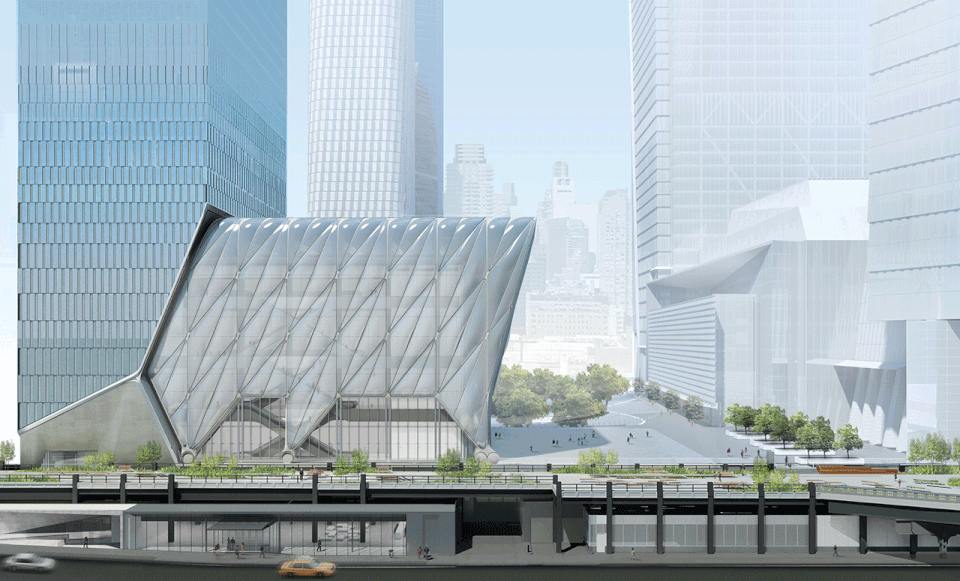
"Flexibility, most of the time, means generic ... I wanted to really challenge that."
"We have people who are sympathetic to technology on the board ... this is a major part of how The Shed's going to succeed."
Video: How The Shed was made
In 2019, people's experiences of museums are not limited to their time at a physical building.
